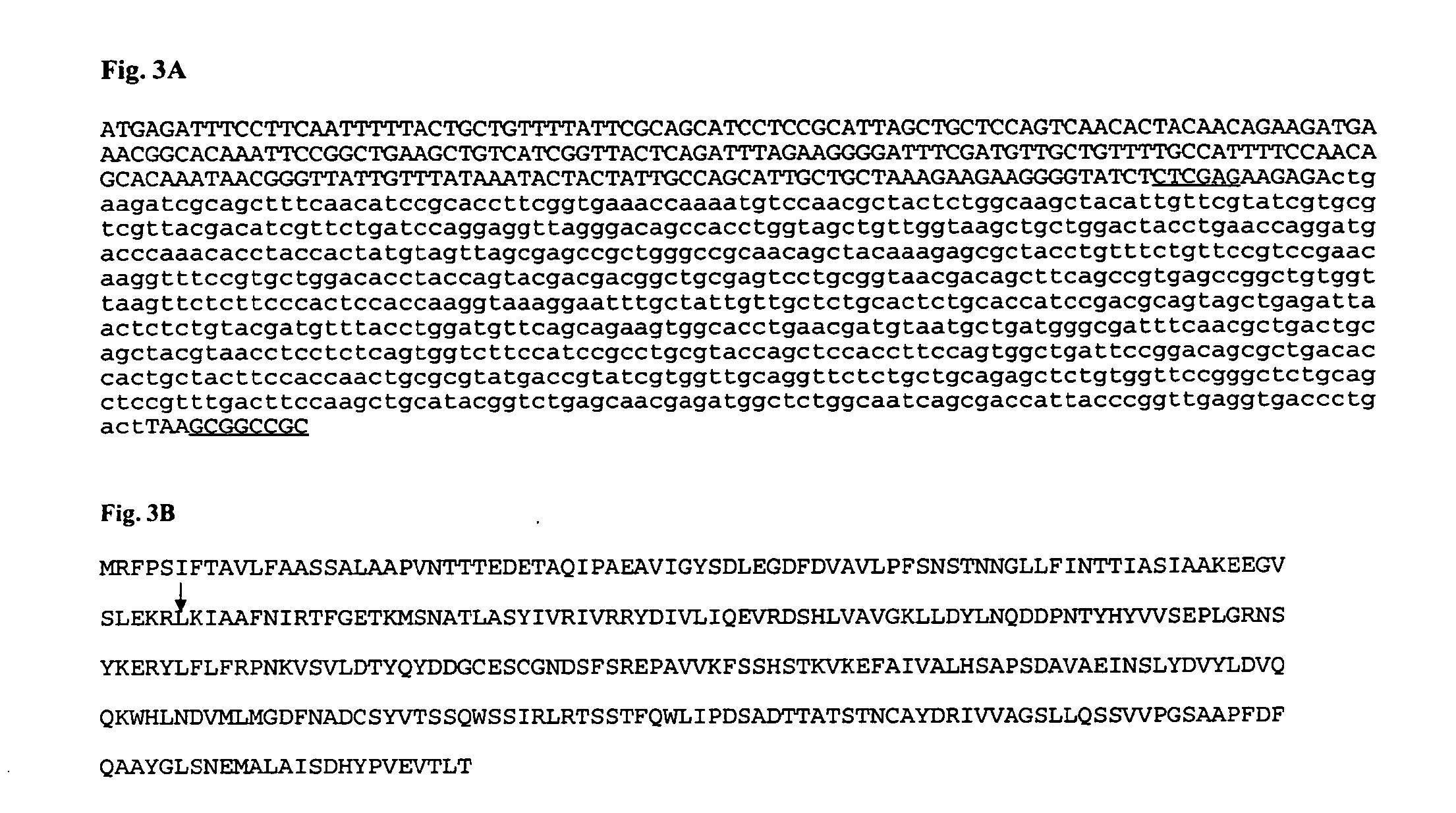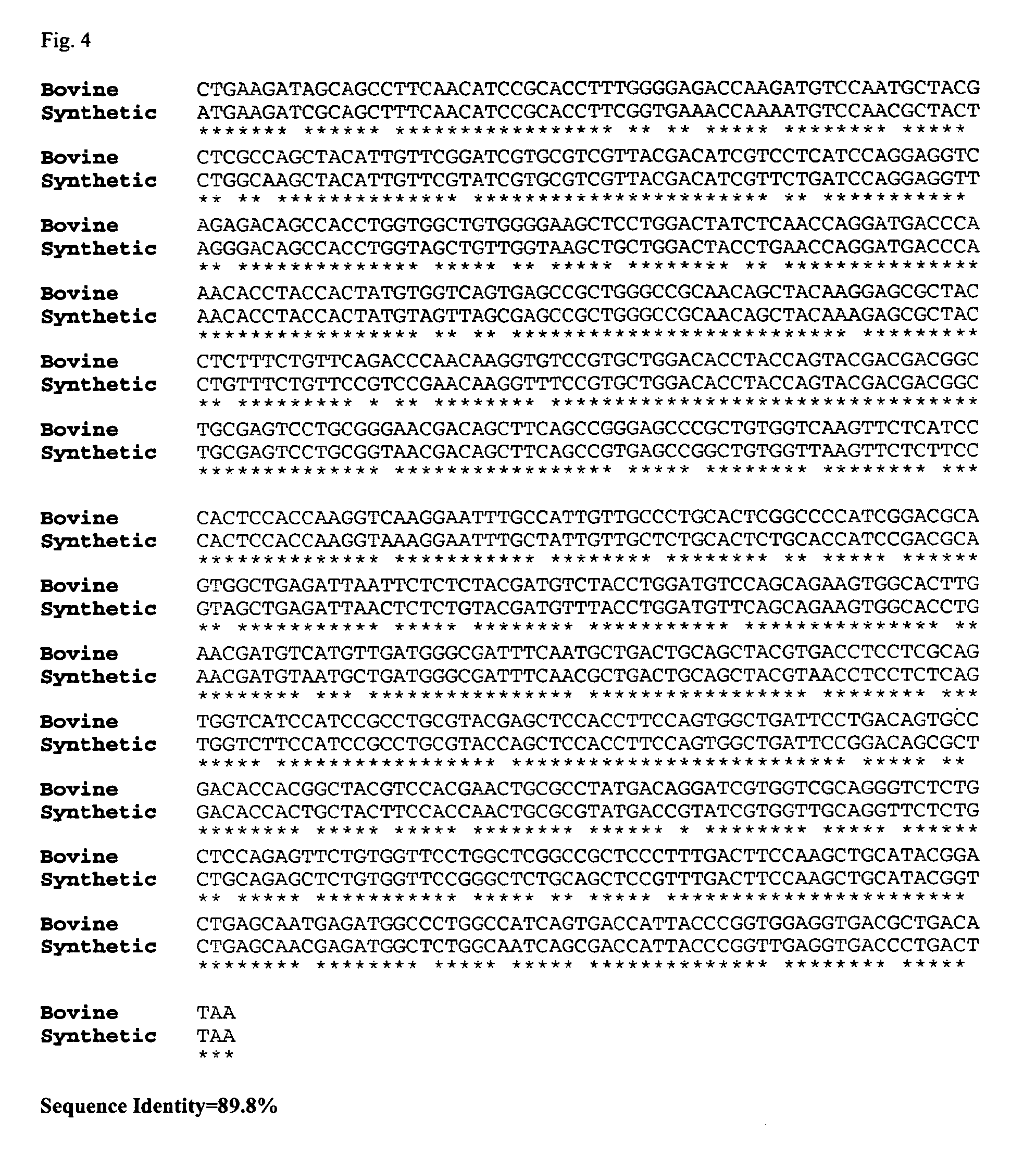Compositions and methods of using a synthetic dnase i
a technology of synthetic dnase and bovine dnase, which is applied in the field of polydeoxyribonucleic acid hydrolase, can solve the problems of unsuitability at low concentrations of enzymes and substrates, and achieve the effects of promoting tight binding by the enzyme, lowering the km of the enzyme for dsdna, and high vmax values
- Summary
- Abstract
- Description
- Claims
- Application Information
AI Technical Summary
Benefits of technology
Problems solved by technology
Method used
Image
Examples
example 1
[0065]Expression of a Synthetic Bovine DNase I in E. coli. DNase I is an extremely toxic protein in E. coli. Inasmuch as this enzyme readily degrades dsDNA, active DNase I in the cytoplasm will cleave bacterial chromosomal DNA and kill the cell. In fact, an effective concentration of DNase I for clearing DNA contamination in advance of RT-PCR (−2.5 nM) is approximately the same as that of a single DNase I molecule in an E. coli cell (assuming a cell volume of ˜1 fL). As a result, non-conventional strategies must be considered to successfully express this protein in reasonably high yield (>5 mg / L).
[0066]The coding portion of the gene for the synthetic bovine DNase I (sbDNase I) was created by assembling oligodeoxynucleotides that were synthesized de novo (FIG. 1). For common molecular biology and protein expression manipulations, procedures were performed as described in Molecular Cloning: A Laboratory Manual (Cold Spring Harbor Press) or Current Protocols in Molecular Biology (J. Wi...
example 2
[0079]Purification of sbDNase I from E. coli. The chromatographic strategy used to purify sbDNase I was based in part by that described by Chen et al. (Protein Science 2002; 11:659-668). Binding of sbDNase I to an anion exchange resin is mediated by its calcium binding properties. In addition to having several weak calcium binding sites, sbDNase I has two strong binding sites that bind with a micromolar Kd. A steric shift to binding free calcium and subsequent conformational change is likely to cause DNase to elute at low calcium concentrations (reportedly 7 mM), although the sbDNase I protein described herein elutes at a higher calcium concentration. Soluble sbDNase I collected from induced BL21(DE3) culture fluid was concentrated and dialyzed, in their case, by an ultrafiltration cell and purified by anion exchange. The sbDNase I activity was loaded onto the column in low ionic strength buffer (20 mM Tris pH 7.5), and eluted using a shallow CaCl2 gradient (0-15 mM).
[0080]The sbDNa...
example 3
[0082]Expression of sbDNase I in P. pastoris. The sbDNase I gene was cloned into the pPICZαA expression vector (Invitrogen), which is a shuttle vector containing the Zeocin resistance marker and yeast alpha-mating factor secretion signal sequence. The following primers were designed using NotI and XhoI restriction sites for insertion into the pPicZalpha plasmid:
sbDNase I sequencepPICZsbDNase-Forward(SEQ ID NO.: 13) XhoI L K I A A F N IATCCGCTCGAGAAGAGACTGAAGATCGCAGCTTTCAACATCpPICZsbDNase-Reverse(SEQ ID NO.: 14) NotI Stop T L T V E VATAAGAATGCGGCCGCTTAAGTCAGGGTCACCTCAACCG
[0083]PAGE-purified primers were used to PCR amplify an ˜800 bp fragment from pET-22b_sbDNase I. This ˜800 bp fragment (˜700 ng) was gel-purified, and digested with 50 U Not I and 20 U Xho I overnight. The pPicZαA vector (1.2 ug) was similarly digested. Both double-digested samples were then gel purified. FIGS. 3A and 3B show the nucleic and amino acid sequences, respectively, of the al...
PUM
 Login to View More
Login to View More Abstract
Description
Claims
Application Information
 Login to View More
Login to View More - R&D
- Intellectual Property
- Life Sciences
- Materials
- Tech Scout
- Unparalleled Data Quality
- Higher Quality Content
- 60% Fewer Hallucinations
Browse by: Latest US Patents, China's latest patents, Technical Efficacy Thesaurus, Application Domain, Technology Topic, Popular Technical Reports.
© 2025 PatSnap. All rights reserved.Legal|Privacy policy|Modern Slavery Act Transparency Statement|Sitemap|About US| Contact US: help@patsnap.com



